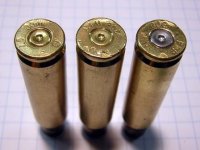While it is unusual, the headstamp actually can be an issue. Most 30-06's today weigh between 180-198 grains, but some ancient Peters cases weighed 215 grains, and it's possible some modern foreign manufacture is like that. I've seen some very heavy South African cases in 223 and cases from former Soviet Block countries in 308 that have very heavy sidewalls starting at about mid-body and down.
Winchester .30-06 cases tend to be on the light end of the spectrum, and I've got examples produced at different times that were 180, 185, or 189 grains, but on the lighter end of the spectrum on average. I mention this because the Hodgdon 30-06 data is developed in Winchester cases, so it can't be counted on to be certain to be safe in very heavy cases.
All that said, weight alone doesn't tell the tale. You need the head dimensions and the alloy used to get more exact. The best thing is to measure inside water weight capacity of the fired cases to see if non-standard design could be an issue.
It sounds from the symptoms like the most likely cause is accidental overcharge. I say this because you have both a primer that apparently looks different from the others and a sticky case extraction. The latter occurs because the steel stretched beyond the yield point of the brass, so that when the steel returned to original size elastically, that brass was now bigger than the original chamber size. That's why it gets trapped a little like an unlubricated case stuck in a sizing die. Once removed, though, I would expect a snug fit going back into the chamber. That's the only part that doesn't fit. Indeed, if it weren't for the primer crater being unique to this round, I would be looking for some other sticking mechanism other than overpressure. But having the two symptoms together says the pressure was high.
While overcharging is the most likely cause, other things can happen. I once had a once-fired (by me) Lake City .30-06 case that felt too heavy when I was trimming, so I weighed it and found it was about 35 grains heavier than was normal for the others. I shined a flashlight down into it and it looked normal except being maybe a little extra dark down near the head. But that was funny enough that I went in with a dental pick to feel around, and the dark spot turned out to be a 35 grain slug of lead bullet core that the pick popped loose. Apparently that piece of core got into the case at the factory. I didn't notice any odd sounds or recoil, but when I got pressure test equipment years later, it turned out this lot of ammo ran at about 48,000 psi, so it had some room for an internal space error like this.
It's not likely you've got a lead slug, but range foundlings, if it was such, often have debris in them. I've found insect nests stuck inside before, and stuck hard enough that it took more than vibratory cleaning to remove them.
Winchester .30-06 cases tend to be on the light end of the spectrum, and I've got examples produced at different times that were 180, 185, or 189 grains, but on the lighter end of the spectrum on average. I mention this because the Hodgdon 30-06 data is developed in Winchester cases, so it can't be counted on to be certain to be safe in very heavy cases.
All that said, weight alone doesn't tell the tale. You need the head dimensions and the alloy used to get more exact. The best thing is to measure inside water weight capacity of the fired cases to see if non-standard design could be an issue.
It sounds from the symptoms like the most likely cause is accidental overcharge. I say this because you have both a primer that apparently looks different from the others and a sticky case extraction. The latter occurs because the steel stretched beyond the yield point of the brass, so that when the steel returned to original size elastically, that brass was now bigger than the original chamber size. That's why it gets trapped a little like an unlubricated case stuck in a sizing die. Once removed, though, I would expect a snug fit going back into the chamber. That's the only part that doesn't fit. Indeed, if it weren't for the primer crater being unique to this round, I would be looking for some other sticking mechanism other than overpressure. But having the two symptoms together says the pressure was high.
While overcharging is the most likely cause, other things can happen. I once had a once-fired (by me) Lake City .30-06 case that felt too heavy when I was trimming, so I weighed it and found it was about 35 grains heavier than was normal for the others. I shined a flashlight down into it and it looked normal except being maybe a little extra dark down near the head. But that was funny enough that I went in with a dental pick to feel around, and the dark spot turned out to be a 35 grain slug of lead bullet core that the pick popped loose. Apparently that piece of core got into the case at the factory. I didn't notice any odd sounds or recoil, but when I got pressure test equipment years later, it turned out this lot of ammo ran at about 48,000 psi, so it had some room for an internal space error like this.
It's not likely you've got a lead slug, but range foundlings, if it was such, often have debris in them. I've found insect nests stuck inside before, and stuck hard enough that it took more than vibratory cleaning to remove them.

